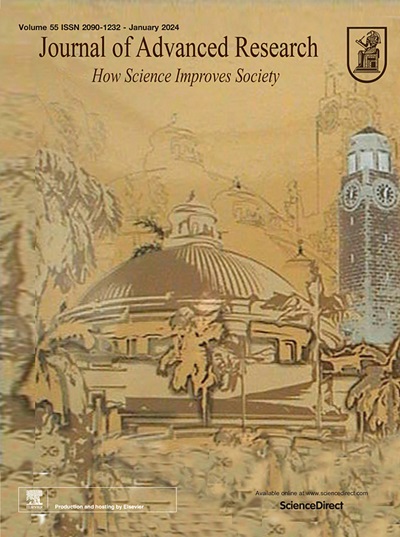IF 11.4
1区 综合性期刊
Q1 MULTIDISCIPLINARY SCIENCES
引用次数: 0
摘要
导言阿尔茨海默病(AD)是痴呆症的主要病因,正在成为威胁人类健康的全球性疾病。加工食品的增加被认为是导致阿尔茨海默病流行的一个重要环境风险因素。目的 采用东莨菪碱诱导的神经炎症细胞模型和转基因APPswe/PSEN1dE9(APP/PS1)AD小鼠,研究了碳聚合物对AD发病的影响,并全面探讨了长期暴露于热加工食品中的碳聚合物对AD进展的毒理机制。方法从热加工食品中提取氯化石蜡,以东莨菪碱诱导的PC12细胞作为神经炎症模型,评估氯化石蜡暴露对神经炎症细胞氧化应激的影响。此外,研究人员还利用 APP/PS1 AD 小鼠,通过 Morris 水迷宫和开阔地测试,验证了长期暴露于氯化石蜡对 AD 进展的潜在不利影响。此外,还对长期暴露于氯化石蜡后的 AD 小鼠的脑组织进行了组织病理学检查,包括免疫荧光、免疫组织化学、Nissl 染色和 H&E,以阐明饮食暴露于氯化石蜡对 AD 进展的潜在风险。电子自旋共振的进一步研究结果证实了氯化石蜡的催化特性,它通过促进自由基的生成加速了氧化损伤。利用转基因 AD 小鼠模型,我们的研究结果还表明,长期暴露于氯化石蜡会加重 AD 相关病理变化,表现为淀粉样β沉积增加和神经胶质细胞活化,最终加速认知能力下降。本文章由计算机程序翻译,如有差异,请以英文原文为准。

Toxicological mechanisms of carbon polymers in accelerating cognitive decline in Alzheimer’s disease
Introduction
Alzheimer’s disease (AD) is the primary cause of dementia and is emerging as a global threat to human health. Increased availability of processed food is identified as a crucial environmental risk factor underlying the prevalence of Alzheimer’s disease. Carbon polymers (CPs), as neo-formed substances and ubiquitous in thermally processed foods, the relationship between them and AD onset is remains unclear.Objectives
The effect of CPs on AD onset was examined and the toxicological mechanisms of prolonged exposure to CPs derived from thermal processed foods on AD progression were comprehensively investigated using a scopolamine-induced neuroinflammatory cell models and the transgenic APPswe/PSEN1dE9 (APP/PS1) AD mouse.Methods
The CPs were extracted from thermally processed foods and the effects of CPs exposure on oxidative stress in neuroinflammatory cells were evaluated using scopolamine-induced PC12 cells as a neuroinflammation model. Furthermore, APP/PS1 AD mice were used to validate the potential adverse impacts of prolonged exposure to CPs on AD progression through the Morris water maze and open field test. In addition, histopathological examination, including immunofluorescence, immunohistochemistry, Nissl staining, and H&E, of the brain tissue in AD mice after chronic CPs treatment was performed to elucidate the underlying risk of dietary exposure to CPs on AD progression.Results
Exposure to CPs enhanced oxidative damage in neuroinflammatory cells, as demonstrated by impaired mitochondrial function and activated NF-κB/MAPK signaling pathways. Further results from electron spin resonance substantiated the catalytic properties of CPs, which accelerated oxidative damage through promoting free radical generation. Using transgenic AD mice model, our findings also demonstrated that prolonged CPs exposure aggravated AD-associated pathology, as evidenced by increased amyloid-beta deposition and glial cell activation, ultimately accelerating cognitive decline.Conclusion
These findings provide compelling evidence of the potential health risks associated with long-term dietary exposure to CPs and provide insight into the relationship between foodborne risk factors and neurodegenerative diseases.求助全文
通过发布文献求助,成功后即可免费获取论文全文。
去求助
来源期刊

Journal of Advanced Research
Multidisciplinary-Multidisciplinary
CiteScore
21.60
自引率
0.90%
发文量
280
审稿时长
12 weeks
期刊介绍:
Journal of Advanced Research (J. Adv. Res.) is an applied/natural sciences, peer-reviewed journal that focuses on interdisciplinary research. The journal aims to contribute to applied research and knowledge worldwide through the publication of original and high-quality research articles in the fields of Medicine, Pharmaceutical Sciences, Dentistry, Physical Therapy, Veterinary Medicine, and Basic and Biological Sciences.
The following abstracting and indexing services cover the Journal of Advanced Research: PubMed/Medline, Essential Science Indicators, Web of Science, Scopus, PubMed Central, PubMed, Science Citation Index Expanded, Directory of Open Access Journals (DOAJ), and INSPEC.
 求助内容:
求助内容: 应助结果提醒方式:
应助结果提醒方式:


